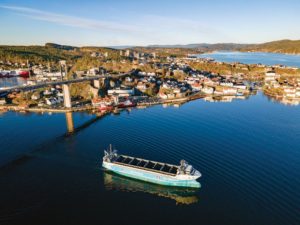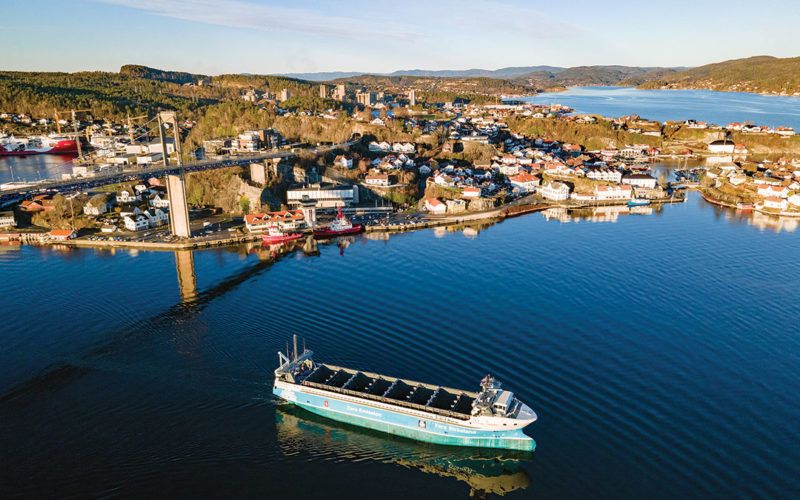The order is given and it’s full speed ahead for robot vessels called maritime autonomous surface ships (MASS).

The technologies being researched and developed are showing no signs of stopping. The International Maritime Organization (IMO) has defined four categories of MASS with differing degrees of autonomy:
• Degree one: Seafarers are on board to operate and control shipboard systems and functions.
• Degree two: Remotely controlled ship with seafarers on board.
• Degree three: Remotely controlled ship without seafarers on board.
• Degree four: Fully autonomous ship with an operating system able to make decisions and determine actions by itself.
The timeline of one ship developer is to have a MASS cargo vessel operational on near-coastal waters by 2025 and another one on international waters by 2035. Many governments are encouraging that research and development with grants based on studies and experiments of their own. That push includes the development of artificial intelligence maneuvering (AIM) for all types of vessels, along with the elimination of all crewmembers.
Ships that are free of any crew on board can sometimes be justified in very specific cases, but ridding professional mariners from large merchant ships is mostly a dangerous idea. This simple fact has not dissuaded advocates from building MASS cargo ships such as Yara Birkeland, a 262-foot vessel currently operating on the inland waters of Norway. It carries 120 containers. Belgium also will be operating one of its own soon that will carry 400 containers. These computer-run ships are mistakenly touted as being safer.
Most vessel collisions are caused by some form of human error. AIM can eliminate most of that by initiating collision avoidance actions sooner and more correctly in compliance with the navigation rules of the road. While interviewing the owner of a ship insurance company, he said that having no crew on board will save money, both in property damage and personal injury claims. That might be true for collisions, but it’s equally true that other areas of shipboard safety will be compromised. This simple fact is ignored by many in favor of MASS economic returns, with savings as much as 30 percent per cargo run for a fully autonomous ship. That’s the real driving force behind MASS. But is it reliable enough to provide those returns?
AIM is a computerized electronic device, and like all electronic devices it is subject to failure. Once AIM fails, MASS is out of luck. When the subject of shipboard fires is brought up, you get the argument that automatic firefighting equipment can be installed on board. Fire sprinklers can put out some common combustible fires, but they cannot take the place of a human firefighting team.
When I asked the insurance company owner what happens if a fire starts in a cargo container not equipped with sprinklers, I was told that it becomes an “acceptable loss.” So who cares if the ship runs into an oil platform or flounders on the rocks and causes a huge oil spill along a coastline? I guess that is an acceptable loss to them too. How many years will it take for the marine environment to recover? What other losses are acceptable to these new MASS shipping companies?
No crew on board means that there is no one to stop terrorists from boarding a large merchant ship and using it as a weapon. I talked to the U.S. Coast Guard about that. They said that MASS vessels will have cameras on board and satellite tracking to alert authorities if that happens. A Coast Guard or Navy strike force could then intercept the ill-doers and neutralize them. If that is the case, we would have to purchase not dozens of warships and aircraft, but thousands more to cover every future MASS merchant ship. Some AIM developers say if assault assets are unavailable at the time to stop piracy and the like, then all they have to do is send a satellite signal to disable the ship. Isn’t technology great?
Technology that allows the owners and operators to remotely shut down a ship also can allow a hacker to take control of it. Now you don’t even have to board it to do damage. All you have to do is hack into the emergency override commands right at a critical juncture and send the ship at full speed into another one. The IMO recognizes the need to prevent this and the need for cybersecurity in MASS. In its interim guidelines for MASS trials, dated June 14, 2019, the IMO states that “appropriate steps should be taken to ensure sufficient cyber-risk management of the systems and infrastructure (in MASS).”
I interviewed a marine cybersecurity expert who told me that there is a definite hacking risk with MASS. The Coast Guard also told me that it is taking cybersecurity seriously, yet it is still considering the reduction of bridge crewmember requirements with MASS. The service cited the past reduction of engineering crewmembers due to automation and monitoring of engine spaces as a precedent for a reduction in MASS bridge crews. That’s bad reasoning. Some MASS uses are valid, but those uses are not for merchant ships.
MASS technology for minesweepers is worth perfecting. Ships sweeping mines were blown up in World War I, World War II, the Korean War and the Vietnam War, resulting in a great loss of life. Landing rockets on zero-crew MASS vessels has a lot of merit, and research vessels and fireboats inserted into high-temperature toxic environments also are good candidates for MASS.
So I’m not anti-MASS, nor am I anti-AIM. AIM can be a great tool for modern-day professional mariners, but it should not replace them. We did not get rid of crews when radar was invented, nor should we now with AIM. It should only be considered as another important piece of collision avoidance electronics for the bridge crew to utilize. That can greatly help our maritime industry and our society.
Where is society heading with MASS? Right now the IMO is conducting a MASS scoping study, the results of which are still pending due to delays caused by the pandemic and the complicated issues involved in legalizing MASS. We know that the U.S. Maritime Administration (MarAd) has been in favor of developing and promoting MASS on merchant ships. It has sponsored studies and conducted some of its own. With the recent resignation of Mark Buzby and the appointment of Lucinda Lessley as the agency’s acting administrator, however, it’s anyone’s guess what future direction MarAd will take when it comes to MASS policies.
Some professional merchant mariners will be retrained to occupy shore-based MASS positions, according to MarAd, but many will lose their jobs. Will the Coast Guard require these new workers to have a master’s license for remotely controlled MASS? The service hasn’t made a decision about that yet. If it decides to issue land-based MASS licenses, will the new masters be strictly classroom taught? If the answer is no, then where and how are they supposed to get their at-sea experience?
If there are no more merchant mariners, then we can’t properly train and promote any more pilots either. The IMO and Coast Guard say they are studying that issue now. AIM cannot anticipate every scenario in a crowded harbor better than a local pilot can. This is another one of MASS’ shortcomings. A professional pilot is always better than AIM.
AIM cannot replace professional crews on large merchant vessels because it simply cannot do all of their jobs. It can’t repair an engine or steering gear underway, nor can it perform preventative maintenance. It certainly cannot strategically fight a shipboard fire or clean out a clogged fire pump to keep automatic sprinklers working. It can’t conduct on-scene flooding prevention after a collision. It can’t render aid to ships in distress, nor can it repel unauthorized boarders. MASS cannot clean up an oil spill or deploy containment booms. It can’t even lash down a piece of gear that comes loose in a storm.
We need MASS to help save lives in very specific instances when vessels are constantly engaged in inherently dangerous operations. In all other cases, the scope should be limited to the role of another piece of marine electronics for onboard personnel to utilize to their advantage. That’s the best way to save money. AIM can be a good thing on most ships at sea as long as a professional crew is on board too. What we need now is for someone to invent some artificial common sense (ACS) to go along with it. •
Capt. Marc Deglinnocenti is a maritime technical writer. His sea time dates to 1974 in a wide variety of roles on sailboats, conventional and tractor tugboats, training ships, barges, warships, cargo ships, passenger vessels and research vessels. He can be reached by emailing oldarmada@gmail.com.

